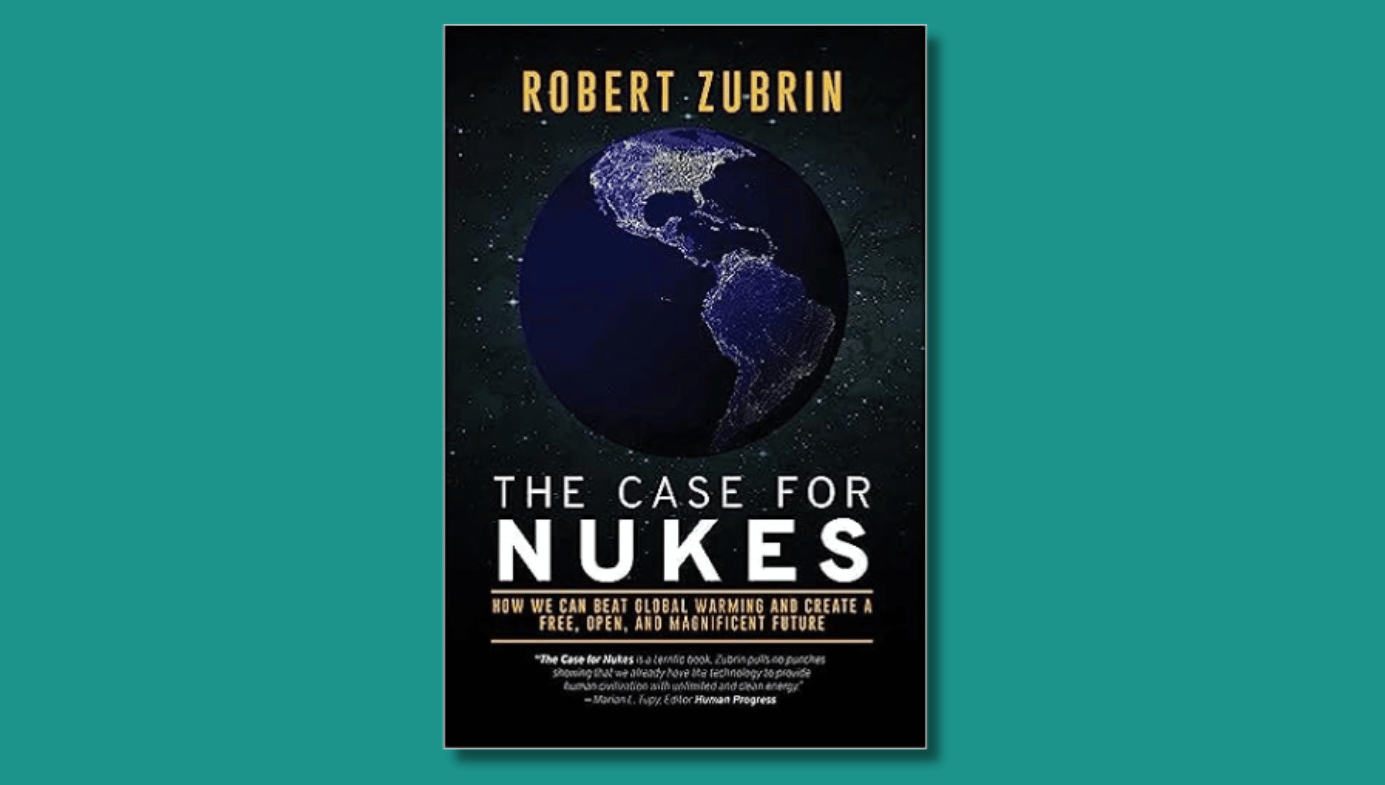
A review of The Case for Nukes: How We Can Beat Global Warming and Create a Free, Open, and Magnificent Future by Robert Zubrin (Polaris Books 2023).
In a very literal sense, energy technologies have molded humanity. The invention of cooking with fire by Homo Habilis cut the metabolic energy needed to digest meat and made it safer to consume, allowing the primates to eat more animals. Evolution directed some of these surplus calories to their brains, enabling the hungry organ to grow in size and ability, leading to Homo Erectus, the forerunner to Homo Sapiens.
Over millennia, humans learned to harness fire to smoke meats, craft pottery, bend metal, and more, forming much of the material basis of the pre-fossil fuel world. Wood power (or what is now called “biomass”) was such a good deal that parts of Europe started running out of forests in the 1700s. Britain was the first nation to innovate itself out of this dilemma, which they did by burning coal.
Mastering coal and other fossil fuels prevented energy scarcity, but also led to an unforeseen revolution in human life. Synthetic fertilizer, electricity, cars, plastics, smart phones, x-rays, ChatGPT—nearly all elements of modern life—exist because of fossil fuels. Today billions of people enjoy a prosperity that would be unimaginable to their ancestors.
This history of energy begins The Case for Nukes. Robert Zubrin, an American aerospace engineer of three decades, has penned seventeen books which span from space travel and terraforming Mars to energy security and environmentalism. In his day job, Zubrin is the President of Pioneer Astronautics, a private aerospace research and development firm whose prior customers include NASA and the US military.

Zubrin tells the history of energy to set the stage for one of his core arguments, that humanity should use more energy. Over 700 million people languish in extreme poverty today and billions have not reached a standard of living equivalent to that of a developed country, a situation Zubrin believes can only be alleviated if energy use increases at least tenfold.
In contrast, some environmentalists urge people to use less energy, which they believe is necessary to avert climate and ecological apocalypse. In 1968, prominent environmentalist Paul Ehrlich wrote in his seminal book The Population Bomb that, “Giving society cheap, abundant energy at this point would be the moral equivalent of giving an idiot child a machine gun.”
Zubrin contends that slashing energy use would be so harmful as to be borderline genocidal, but he recognizes that the environmental harms of fossil fuels are unsustainable. Thus he endorses nuclear energy, asserting that only atomic energy can lift all people out of poverty while conserving the environment.
Zubrin makes a strong case that nuclear plants are safe. Unlike what the fear-mongers say, nuclear reactors cannot explode like atomic bombs; it is impossible thanks to the laws of physics. Atomic explosions can only occur if large quantities of highly-enriched fissile material are pummeled with fast neutrons nearly instantaneously. A nuclear reactor contains only low-enriched fuel and cannot create fast neutrons, and thus cannot produce the devastation of an atomic weapon.
To quell radiation fears, Zubrin notes that nuclear reactors actually reduce the amount of radiation that enters the atmosphere. One 1000 MW natural gas plant releases more radiation every month than the entire Three Mile Island nuclear accident, one of the worst nuclear accidents in history.
Nuclear waste is a non-issue. Nuclear waste has never hurt anyone and there is very little of it. One 1000 MW coal plant releases more toxic waste in a day than the US nuclear industry does in a year. The nuclear waste issue also reveals the duplicity of the anti-nuclear movement. Civilian nuclear waste can be safely stored in geologically stable rock formations, a solution already implemented by the US military for its nuclear program, but anti-nuclear activists campaign relentlessly against such a policy for civilian nuclear energy. They then attack nuclear energy as “polluting” because its waste does not have a permanent storage site.
Zubrin also makes a compelling case that cost and time overruns that plague nuclear construction in the US can be solved. For example, the US’s newest reactors, Vogtle 3 and 4, together cost over $30 billion and have been under construction since 2009 (Vogtle 3 went online in April). But the US built nuclear plants in 5 years on average in the 1960s at a cost of several hundred of million dollars, not billions. So what changed?
Simply put, the US federal government has strangled the American nuclear industry with an oppressive regulatory regime. This can be readily seen in the quantity of materials needed for construction. Between the early and late 1970s, the amount of concrete, electrical cable, and steel increased by 27, 36, and 41 percent, respectively.
It gets worse. The Nuclear Regulatory Commission (NRC) sometimes alters regulations mid-construction, forcing crews to reconfigure already completed systems. To prepare for such situations, builders will include features not required by regulators in original designs, only to see the fresh mandate never materialize.
Zealous rule making increases the time it takes to construct a nuclear plant, which Zubrin argues is the primary driver of skyrocketing costs. Longer construction times increase labor costs, interest rate payments, and inflation. Indeed, every added day of construction typically costs more than a million dollars per day.
Overregulation may actually make nuclear plants less safe. While employed by a state government in the late 1980s, Zubrin coordinated with the operators of a nuclear plant which had to shut down for several months every year to replace corroded piping. The operators concluded that simply changing the piping from carbon steel to stainless would fix the issue, but NRC rules required the company to apply for a new operating license to make such a change, an arduous, costly process by the 80s. Thus, the plant operators did not fix the issue and permanently closed the plant a few years later.

This system exists because of the false safety claims popularized by anti nuclear activists. In 1974, the Executive Director of the Sierra Club, the US’s largest environmental group, issued a memo describing their strategy: “Our campaign for stressing the hazards of nuclear power will supply a rationale for increasing regulation… and add to the cost of the industry.”
Fortunately, most of the book does not dwell on the asphyxiation of nuclear. To describe the arrangement of nuclear reactor components, Zubrin entertains the reader by putting her in the shoes of someone who wants to build her first nuclear reactor. “Excellent pressure vessels can be purchased from the Westinghouse company. They are expensive, however, so ask about their layaway plan.”
In another dose of humor, he warns: “If you are a minor, be sure to get your parents’ permission before building or operating a fusor as it may cause parts of your home to become radioactive, which could negatively impact its resale value and get you in trouble.”
Zubrin relays the story of nuclear reactor development, which shows, among other things, that nuclear engineers have guts. The first nuclear reactor ever constructed, Chicago Pile-1, was built underneath the football stadium of the University of Chicago. For its last resort safety system, a professor stood by with a bucket of concentrated cadmium nitrate to hurl onto the reactor. Fortunately for the UChicago football team, the Pile-1 generated heat from fission without incident.
Later the book describes the creation of the US nuclear navy, which almost never got off to sea. US Navy higher-ups tried to kill the program, fearing nuclear-propelled submarines would make aircraft carriers, their area of expertise, obsolete.
In response to this political pressure, then-Captain Hyman Rickover, tasked with forging the nuclear navy, rushed the submarine reactor R&D. He passed on purchasing a scaled-down test reactor for the first tests, instead ordering a submarine-sized reactor. During its first test at full power, the officers on site ordered the engineers to halt the test after the reactor, the Mark I, operated for twenty four hours. Rickover overruled them and simulated a course across the Atlantic.

After 60 hours, the reactor’s instrumentation and cooling pumps developed problems, along with a condenser tube. Instead of stopping, Rickover instructed his engineers to fix the reactor while it ran at full power, saying “If the plant has a limitation so serious, now is the time to find out. I accept full responsibility for any casualty.”
After 100 hours, the submarine had effectively sailed across the Atlantic, besting the previous record of 20 submerged miles at full power. Here Rickover ended the test. The captain gave his reason for such a brash course, “We had to do it today. They never would have given us a second chance.”
The history of bravery in the nuclear industry exhilarates, as does Zubrin’s subsequent discussion of nuclear powered space travel. A fission-fueled spacecraft could theoretically hit speeds of 12,800 km/s, dwarfing the maximum possible speed of a chemical powered craft of 5 km/s. At this velocity, the fission spacecraft could attain 8 percent the speed of light and reach Alpha Centauri, the star nearest our solar system, in 54 years. Unfortunately, such a speed demands perfect conversion of nuclear energy into thrust which is impossible with current technology. A more reachable speed in the near term is 9 to 50 km/s, still a substantial improvement over chemical fuels.
Because nuclear engineers live dangerously, the simultaneous advent of nuclear weapons and the Space Race led the US Atomic Energy Commission, the predecessor to the NRC, to explore propelling spacecraft with atomic bombs (seriously), which could theoretically reach speeds of 3,000 km/s, one percent the speed of light. Zubrin’s description of engineering of this actual program, Project Orion, is quite delightful for readers who enjoy the quixotic. Of course, the venture was for naught; the US and USSR wisely prohibited the stationing of nuclear weapons in outer space in the 1963 Test Ban Treaty.
Being what the internet would call a “nuke bro,” Zubrin argues that fashionable solar and wind projects cannot meet humanity’s energy needs; however, his review of these technologies is too brief given their political success and general popularity. Zubrin also fails to discuss the relationship between nuclear energy and nuclear weapons. While a nation can create a nuclear bomb without a nuclear energy program, the book would be more complete had he discussed proliferation.
Regardless, The Case for Nukes is a persuasive and engaging look at an indispensable technology. Philosophically The Case for Nukes falls firmly within the ecomodernist tradition, a school of thought that sees advancing technology and human prosperity as necessary to preserve an ecologically vibrant planet. Nuclear enthusiasts, physics students, and those interested in optimistic environmentalism would do well to buy a copy of this stimulating book.





